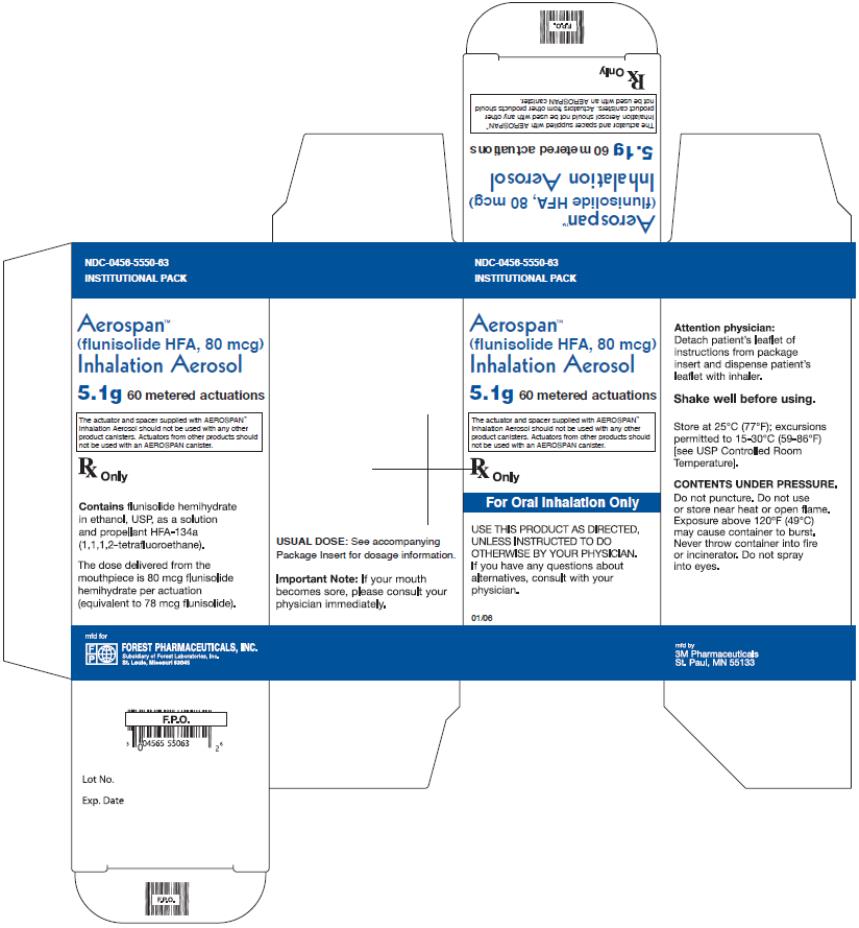AEROSPAN- flunisolide aerosol, metered
Allergan, Inc.
----------
AEROSPANTM
(flunisolide HFA, 80 mcg)
Inhalation Aerosol
For Oral Inhalation Only
Rx Only
DESCRIPTION
Flunisolide hemihydrate, the active component of AEROSPANTM (flunisolide HFA, 80 mcg) Inhalation Aerosol, is a corticosteroid having the chemical name 6α-Fluoro-11β, 16α, 17, 21 –tetrahydroxylpregna-1, 4-diene-3, 20-dione cyclic-16, 17-acetal with acetone, hemihydrate and the following chemical structure:

Flunisolide hemihydrate is a white to creamy white crystalline powder with a molecular weight of 443.51 and an empirical formula of C24H31O6F •½ H2O. It is soluble in acetone, ethyl alcohol and HFA-134a and practically insoluble in water.
AEROSPAN Inhalation Aerosol is a pressurized, metered-dose inhaler unit intended for oral inhalation only. The inhaler unit consists of a metal canister, a purple actuator, and a gray spacer. Each unit contains a 0.24 % w/w solution of flunisolide hemihydrate in 10:90 w/w ethanol:1,1,1,2-tetrafluoroethane (HFA 134a). After priming, each actuation delivers 139 mcg of flunisolide hemihydrate in 58 mg of solution from the canister valve and 80 mcg of flunisolide hemihydrate (equivalent to 78 mcg flunisolide) from the spacer at a flow rate of 30 L/min for 4 seconds.
Using an in-vitro method at a fixed volume of 2 L, each actuation at the beginning of canister content delivers from the spacer 76 mcg (95% of the label claim) at a flow rate of 30 L/min, 61 mcg (76% of the label claim) at a flow rate of 20 L/min, 85 mcg (106% of the label claim) at a flow rate of 40 L/min, and 96 mcg (120% of the label claim) at a flow rate of 60 L/min. The actual amount of drug delivered to the lung may depend upon patient factors, such as timing and coordination between the actuation and inspiration and the strength and duration of the inspiration. Data show that both the one- and two-actuation doses are depleted by 75% or more after waiting one second between actuation and inhalation.
The 5.1-g net weight canister provides 60 metered actuations and the 8.9-g net weight canister provides 120 metered actuations.
AEROSPAN Inhalation Aerosol should be primed before using for the first time by releasing 2 test sprays into the air away from the face. In cases where the inhaler has not been used for more than 2 weeks, the inhaler should be primed again by releasing 2 test sprays into the air away from the face.
This product does not contain chlorofluorocarbon (CFC).
CLINICAL PHARMACOLOGY
Mechanism of Action: Flunisolide has demonstrated marked anti-inflammatory activity in classical test systems. It is a corticosteroid that is several hundred times more potent than cortisol in animal anti-inflammatory assays, and several hundred times more potent than dexamethasone in anti-inflammatory effect as determined by the McKenzie skin blanching test. The clinical significance of these findings is unknown.
Airway inflammation in both large and small airways is an important component in the pathogenesis of asthma. Corticosteroids have been shown to have a wide range of anti-inflammatory effects, inhibiting both inflammatory cells and release of inflammatory mediators. It is presumed that these anti-inflammatory actions play an important role in the efficacy of flunisolide in controlling symptoms and improving lung function in asthma. Inhaled flunisolide probably acts topically at the site of deposition in the bronchial tree after inhalation.
Pharmacokinetics:
All the data described below is based on studies conducted in subjects 18 to 51 years of age.
Absorption: Flunisolide is rapidly absorbed after oral inhalation. Mean values for the time to maximum concentration, Tmax, of flunisolide range from 0.09 to 0.17 hr after a single 320 mcg dose of AEROSPAN Inhalation Aerosol. The corresponding mean values for the maximum concentration, Cmax, of flunisolide vary from 1.9 to 3.3 ng/mL. Oral bioavailability is less than 7%. Over the dose range of 80 mcg to 320 mcg of AEROSPAN Inhalation Aerosol, values for Cmax increase proportionately with dose after single as well as multiple dose administration.
Distribution: Flunisolide is extensively distributed in the body, with mean values for apparent volume of distribution ranging from 170 to 350 L after a single 320 mcg dose of AEROSPAN Inhalation Aerosol.
Metabolism: Flunisolide is rapidly and extensively converted to 6ß-OH flunisolide and to water-soluble conjugates during the first pass through the liver. Conversion to 6ß-OH flunisolide, the only circulating metabolite detected in man, is thought to occur via the cytochrome P450 enzyme system, particularly the enzyme CYP3A4. 6ß-OH flunisolide has a low corticosteroid potency (ten times less potent than cortisol and more than 200 times less potent than flunisolide). Maximum levels of 6ß-OH flunisolide were 0.66 mcg/mL after a single 320 mcg dose of AEROSPAN Inhalation Aerosol, and 0.71 mcg/mL after multiple doses of AEROSPAN Inhalation Aerosol.
Excretion: Urinary excretion of flunisolide is low. Less than 1% of the administered dose of flunisolide is recovered in urine after inhalation. The half-life values for 6ß-OH flunisolide range from 3.1 to 5.1 hrs after administration of AEROSPAN Inhalation Aerosol in the dose range of 160 mcg to 320 mcg.
Disposition and Elimination: Twice daily inhalation administration of flunisolide hemihydrate for up to 14 days did not result in appreciable accumulation of flunisolide. Upon multiple dosing with 160 mcg and 320 mcg, the Cmax values were 1.0 ng/mL and 2.1 ng/mL, respectively. The corresponding AUC0-12hr values were 1.2 ng.hr/mL and 2.5 ng.hr/mL.
Flunisolide is rapidly cleared from the body, independent of route of administration or dose administered. Flunisolide is not detectable in plasma twelve hours post-dose. After administration of 320 mcg of AEROSPAN Inhalation Aerosol the elimination half-life ranges from to 1.7 hours. After a single 320 mcg dose, mean oral clearance values, not adjusted for bioavailability, range from 83 to 167 L/hr.
Special Populations: There were no gender differences for flunisolide after single and multiple dose administration of the AEROSPAN Inhalation Aerosol. Formal pharmacokinetic studies using flunisolide were not carried out in any other special populations.
Pharmacodynamics: Dose finding for AEROSPAN Inhalation Aerosol was based on comparability of systemic exposure to flunisolide CFC inhalation aerosol. The effect of flunisolide CFC inhalation aerosol and AEROSPAN Inhalation Aerosol on pharmacokinetics and 12-hour plasma cortisol levels was investigated in two studies. In both studies, the Cmax and AUC of flunisolide, 6β-OH flunisolide, and 12-hour plasma cortisol measurements were comparable for 1000 mcg of flunisolide CFC inhalation aerosol and 320 mcg of AEROSPAN Inhalation Aerosol. The first was a parallel arm study in 31 subjects. Pharmacokinetics and plasma cortisol levels were determined after single and multiple doses of flunisolide CFC inhalation aerosol 1000 µg and AEROSPAN Inhalation Aerosol 160 µg or 320 µg administered twice daily for 13.5 days. At steady state, flunisolide mean peak plasma concentrations from flunisolide CFC inhalation aerosol 1000 mcg and AEROSPAN Inhalation Aerosol 320 mcg were found to be 2.6 ng/mL and 3.4 ng/mL, respectively. The corresponding mean AUC values for the 12-hr dosing interval were 5.7 ng.hr/mL and 4.7 ng.hr/mL, respectively. At steady state, the mean peak plasma concentrations of 6β-OH flunisolide from flunisolide CFC inhalation aerosol 1000 mcg and AEROSPAN Inhalation Aerosol 320 mcg were found to be 0.9 ng/mL and 0.3 ng/mL, respectively. The corresponding mean AUC values for the 12-hr dosing interval were 3.8 ng.hr/mL and 1.1 ng.hr/mL, respectively. The second was a crossover study in 11 subjects after single doses of flunisolide CFC inhalation aerosol 1000 mcg or AEROSPAN Inhalation Aerosol 320 mcg. The mean peak plasma concentrations of flunisolide from the flunisolide CFC inhalation aerosol 1000 mcg and AEROSPAN Inhalation Aerosol 320 mcg were found to be 2.5 ng/mL and 3.3 ng/mL, respectively. The corresponding mean AUC values were 5.1 ng.hr/mL and 5.8 ng.hr/mL, respectively. The mean peak plasma concentrations of 6β-OH flunisolide from flunisolide CFC inhalation aerosol 1000 mcg and AEROSPAN Inhalation Aerosol 320 μg were found to be 0.8 ng/mL and 0.3 ng/mL, respectively. The corresponding mean AUC values were 3.8 ng.hr/mL and 2.3 ng.hr/mL, respectively.
Controlled clinical studies with flunisolide CFC inhalation aerosol included over 500 treated asthma patients, among them 150 children aged 6 years and older. Open label studies of two years or more duration included more than 120 treated patients. No significant adrenal suppression attributed to flunisolide was seen in these studies.
The potential effects of AEROSPAN Inhalation Aerosol and flunisolide CFC inhalation aerosol on the hypothalamic-pituitary-adrenal (HPA) axis were studied in 2 placebo- and active-controlled studies and 2 active-controlled, open label, long-term studies (see CLINICAL TRIALS). In the placebo-controlled studies, the ability to increase cortisol production in response to stress was assessed by the 60 minute cosyntropin (ACTH) stimulation test. For adult and adolescent patients treated with AEROSPAN Inhalation Aerosol 80 mcg, 160 mcg, 320 mcg, or placebo twice daily for 12 weeks, 92% (22/24), 93% (26/28), 93% (26/28), and 92% (22/24) of patients, normal at baseline, respectively, continued to have a normal stimulated cortisol response (peak cortisol ≥18 mcg/dL and an increase in plasma cortisol ≥7 mcg/dL within 60 minutes after cosyntropin injection) at trial’s end. All patients had peak cortisol levels ≥ 18mcg/dL. There was no significant suppression of 24 hour urinary cortisol, and 100% (96/96) of patients treated with AEROSPAN Inhalation Aerosol had normal morning serum cortisol levels at the end of study. For pediatric patients treated with the AEROSPAN Inhalation Aerosol, 80 mcg and 160 mcg or placebo twice daily for 12 weeks, 91% (31/34), 97% (28/29), and 89% (24/27) of patients, respectively, continued to have a normal stimulated cortisol response (as defined above) at trial’s end. No suppression of 24-hour urinary cortisol was noted. In these studies, comparable results were obtained in patients treated with flunisolide CFC inhalation aerosol.
In the active-controlled, open label, long-term studies, 99.4% (161/162) of adult and adolescent patients and 98.4% (126/128) pediatric patients treated with AEROSPAN Inhalation Aerosol had normal morning serum cortisol levels (≥ 5 mcg/dL) after 12 or 52 weeks of treatment, respectively. For patients treated with AEROSPAN Inhalation Aerosol, 92.5% (99/107) continued to have a normal stimulated plasma cortisol response to cosyntropin at trial’s end with all having peak cortisol levels ≥ 18mcg/dL. In these studies, no suppression of 24-hour urinary cortisol was noted, and comparable results were obtained in patients treated with flunisolide CFC inhalation aerosol.
CLINICAL TRIALS
The efficacy of AEROSPAN Inhalation Aerosol has been studied in two double-blind, parallel, placebo-and active-controlled clinical studies of 12 weeks duration involving more than 1250 patients. In patients 12 to 78 years of age, efficacy was evaluated in patients previously treated with inhaled corticosteroids. In patients 6 to 11 years of age, efficacy was evaluated in patients previously treated with bronchodilators alone or inhaled corticosteroids. Both studies had a 2-week run-in period followed by a 12-week randomized treatment period. During the run-in period all patients received flunisolide CFC inhalation aerosol 500 mcg twice daily. Patients were then randomized to double-blind treatment with different doses of AEROSPAN Inhalation Aerosol or flunisolide CFC inhalation aerosol and monitored for lung function changes to see if they maintained, improved, or lost stability. Baseline was assessed at the end of the run-in period. The primary endpoint was the change from baseline in percent predicted FEV1 after 12 weeks treatment.
Adult and Adolescent Patients with Asthma
Efficacy was evaluated in 669 asthma patients, age 12 to 78 years of age, including 88 patients 12-17 years of age and 581 patients 18 years and older. Mean FEV1 at screening was 2.44 L and mean FEV1 at baseline was 2.72 L following the 2-week run-in period. Patients were randomized to AEROSPAN Inhalation Aerosol 80 mcg, 160 mcg or 320 mcg twice daily, flunisolide CFC inhalation aerosol 250 mcg, 500 mcg, or 1000 mcg twice daily, or placebo. Change from baseline in percent predicted FEV1 over 12 weeks treatment demonstrated that placebo patients deteriorated 4.3% from baseline after 12 weeks of treatment, whereas patients treated with AEROSPAN Inhalation Aerosol 160 mcg or 320 mcg twice daily maintained FEV1 over the course of the study. Results for the comparison to placebo were statistically significant for the 160 and 320 mcg twice daily AEROSPAN Inhalation Aerosol doses (see Figure below), but not for the 80 mcg dose. Secondary endpoints of AM peak expiratory flow rate, AM and PM asthma symptoms, nocturnal awakenings requiring a β2 agonist, and as needed use of inhaled β2 agonists showed differences from baseline favoring AEROSPAN Inhalation Aerosol over placebo. AEROSPAN Inhalation Aerosol and flunisolide CFC inhalation aerosol gave comparable results.
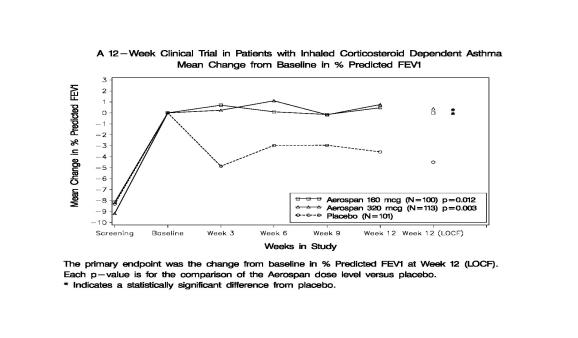
Pediatric Patients with Asthma
The study enrolled 583 asthma patients, 4 to 11 years of age, although the primary efficacy parameter was evaluated only in the population of 513 patients 6 to 11 years of age. In these patients, the mean FEV1 at screening was 81.2% predicted, and the mean FEV1 at baseline following a two week run-in period was 87.5% predicted. Patients were randomized to AEROSPAN Inhalation Aerosol 80 mcg or 160 mcg twice daily, flunisolide CFC inhalation aerosol 250 mcg or 500 mcg twice daily, or placebo. Change from baseline in percent predicted FEV1 over 12 weeks in patients 6 years of age and older demonstrated that placebo patients deteriorated 4.0% from baseline after 12 weeks of treatment, whereas patients treated with AEROSPAN Inhalation Aerosol 80 mcg or 160 mcg twice daily maintained FEV1 over the course of the study. Results for the comparison to placebo were statistically significant for the 80 mcg and 160 mcg doses doses of AEROSPAN Inhalation Aerosol, but there was no added benefit for the 160 mcg BID dose over the 80 mcg BID dose (see Figure below). AEROSPAN Inhalation Aerosol and flunisolide CFC inhalation aerosol gave comparable results in patients 6 years of age and older.
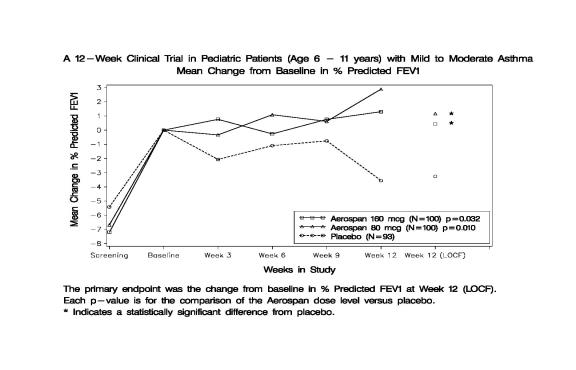
INDICATIONS AND USAGE
AEROSPAN Inhalation Aerosol is indicated for the maintenance treatment of asthma as prophylactic therapy in adult and pediatric patients 6 years of age and older. AEROSPAN Inhalation Aerosol is also indicated for asthma patients requiring oral corticosteroid therapy, where adding AEROSPAN Inhalation Aerosol may reduce or eliminate the need for oral corticosteroids.
AEROSPAN Inhalation Aerosol is NOT indicated for the relief of acute bronchospasm.
CONTRAINDICATIONS
AEROSPAN Inhalation Aerosol is contraindicated in the primary treatment of status asthmaticus or other acute episodes of asthma where intensive measures are required.
Hypersensitivity to flunisolide or any of the ingredients of this preparation contraindicates the use of AEROSPAN Inhalation Aerosol.
WARNINGS
Particular care is needed in patients who are transferred from systemically active corticosteroids to AEROSPAN Inhalation Aerosol because deaths due to adrenal insufficiency have occurred in asthmatic patients during and after transfer from systemic corticosteroids to less systemically available inhaled corticosteroids. After withdrawal from systemic corticosteroids, a number of months are required for recovery of hypothalamic-pituitary-adrenal (HPA) function.
Patients who have been previously maintained on 20 mg or more per day of prednisone (or its equivalent) may be most susceptible, particularly when their systemic corticosteroids have been almost completely withdrawn. During this period of HPA suppression, patients may exhibit signs and symptoms of adrenal insufficiency when exposed to trauma, surgery or infections (particularly gastroenteritis) or other conditions associated with severe electrolyte loss. Although AEROSPAN Inhalation Aerosol may provide control of asthmatic symptoms during these episodes, in recommended doses it supplies less than the physiologic amounts of glucocorticoid systemically and does NOT provide the mineralocorticoid activity that is necessary for coping with these emergencies.
During periods of stress or a severe asthmatic attack, patients who have been withdrawn from systemic corticosteroids should be instructed to resume systemic steroids (in large doses) immediately and to contact their physician for further instruction. These patients should also be instructed to carry a warning card indicating that they may need supplementary systemic steroids during periods of stress or a severe asthma attack.
Patients requiring oral corticosteroids should be weaned slowly from systemic corticosteroid use after transferring to AEROSPAN Inhalation Aerosol. Lung function (FEV1 or AM PEF), beta-agonist use, and asthma symptoms should be carefully monitored during withdrawal of oral corticosteroids. In addition to monitoring asthma signs and symptoms, patients should be observed for signs and symptoms of adrenal insufficiency such as fatigue, lassitude, weakness, nausea and vomiting, and hypotension.
Transfer of patients from systemic corticosteroid therapy to AEROSPAN Inhalation Aerosol may unmask allergic conditions previously suppressed by the systemic corticosteroid therapy, e.g. rhinitis, conjunctivitis, eczema, arthritis, and eosinophilic conditions.
Patients who are on drugs that suppress the immune system are more susceptible to infections than healthy individuals. Chickenpox and measles, for example, can have a more serious or even fatal course in non-immune children or adults on corticosteroids. In such children or adults who have not had these diseases or been properly immunized, particular care should be taken to avoid exposure. How the dose, route, and duration of corticosteroid administration affects the risk of developing a disseminated infection is not known. The contribution of the underlying disease and/or prior corticosteroid treatment to the risk is also not known. If exposed to chickenpox, prophylaxis with varicella-zoster immune globulin (VZIG) may be indicated. If exposed to measles, prophylaxis with pooled intramuscular immunoglobulin (IG) may be indicated. (See the respective package inserts for complete VZIG and IG prescribing information.) If chickenpox develops, treatment with antiviral agents may be considered.
AEROSPAN Inhalation Aerosol is not a bronchodilator and is not indicated for rapid relief of bronchospasm.
As with other inhaled asthma medications, bronchospasm may occur with an immediate increase in wheezing after dosing. If bronchospasm occurs following dosing with AEROSPAN Inhalation Aerosol, it should be treated immediately with a fast-acting inhaled bronchodilator. Treatment with AEROSPAN Inhalation Aerosol should be discontinued and alternative therapy instituted.
Patients should be instructed to contact their physician immediately when episodes of asthma that are not responsive to bronchodilators occur during the course of treatment with AEROSPAN Inhalation Aerosol. During such episodes, patients may require therapy with systemic corticosteroids.
PRECAUTIONS
General: During withdrawal from oral corticosteroids, some patients may experience symptoms of systemically active corticosteroid withdrawal, e.g., joint and/or muscular pain, lassitude and depression, despite maintenance or even improvement of respiratory function. (See DOSAGE AND ADMINISTRATION for details.)
In responsive patients, flunisolide may permit control of asthmatic symptoms with less suppression of HPA axis function than therapeutically equivalent oral doses of prednisone. Since flunisolide is absorbed into the circulation and can be systemically active, the beneficial effects of AEROSPAN Inhalation Aerosol in minimizing or preventing HPA axis dysfunction may be expected only when recommended dosages are not exceeded and individual patients are titrated to the lowest effective dose. Since individual sensitivity to effects on cortisol production exists, physicians should consider this information when prescribing AEROSPAN Inhalation Aerosol.
Because of the possibility of systemic absorption of inhaled corticosteroids, patients treated with AEROSPAN Inhalation Aerosol should be observed carefully for any evidence of systemic corticosteroid effects. Particular care should be taken in observing patients post-operatively or during periods of stress for evidence of inadequate adrenal response.
It is possible that systemic corticosteroid effects such as hypercorticism, reduced bone mineral density, and adrenal suppression may appear in a small number of patients, particularly at higher doses. If such changes occur, the AEROSPAN Inhalation Aerosol dose should be reduced slowly, consistent with accepted procedures for management of asthma symptoms and for tapering of systemic corticosteroids.
The long-term local and systemic effects of AEROSPAN Inhalation Aerosol in human subjects are not fully known. In particular, the effects resulting from chronic use of AEROSPAN Inhalation Aerosol on developmental or immunologic processes in the mouth, pharynx, trachea, and lung are unknown.
Orally inhaled corticosteroids, including flunisolide, may cause a reduction in growth velocity when administered to pediatric patients. A reduction in growth velocity may occur as a result of inadequate control of asthma or from use of corticosteroids for treatment. The potential effects of prolonged treatment on growth velocity should be weighed against clinical benefits obtained and the risks associated with alternative therapies. To minimize the systemic effects of orally inhaled corticosteroids, including AEROSPAN Inhalation Aerosol, each patient should be titrated to his/her lowest effective dose. (See PRECAUTIONS, Pediatric Use.)
Inhaled corticosteroids should be used with caution, if at all, in patients with untreated active or quiescent tuberculosis infection of the respiratory tract; untreated systemic fungal, bacterial, parasitic or viral infections; or ocular herpes simplex.
Rare instances of glaucoma, increased intraocular pressure, and cataracts have been reported in patients following the long- term administration of inhaled corticosteroids.
In clinical studies with flunisolide, localized infections with Candida albicans or Aspergillus have occurred in the mouth and pharynx and occasionally in the larynx. These infections may require treatment with appropriate antifungal therapy and/or discontinuance of treatment with AEROSPAN Inhalation Aerosol.
Information for Patients:
Patients being treated with AEROSPAN Inhalation Aerosol should receive the following information and instructions. This information is intended to aid in the safe and effective use of this medication. It is not a disclosure of all possible adverse or beneficial effects. See Patient Information and illustrated Instructions for Using Your AEROSPAN Inhalation Aerosol for supplemental information.
- Patients should be advised that the effectiveness of AEROSPAN Inhalation Aerosol depends on its regular use and on the proper inhalation-administering technique (see Patient Information and illustrated Instructions for Using Your AEROSPAN Inhalation Aerosol).
- It is important that patients are instructed to begin inhalation immediately prior to actuation. A delay between actuation and inhalation will lead to inadequate drug delivery from the spacer to the patient. Data show that doses are depleted by 75% or more after waiting one second between actuation and inhalation.
- Two to 4 weeks may pass before maximum benefit is obtained after starting AEROSPAN Inhalation Aerosol. If symptoms do not improve, or if the condition worsens, patients should not increase dosage, but should contact the physician immediately.
- Patients should be advised that AEROSPAN Inhalation Aerosol is not a bronchodilator and is not intended for relief of acute asthma symptoms. Patients should be made aware the AEROSPAN Inhalation Aerosol is a controller therapy for asthma, and that it should be taken regularly even if they are asymptomatic.
- Patients should be instructed to prime the inhaler by releasing two test sprays into the air away from the face before first use of AEROSPAN Inhalation Aerosol, and when the inhaler has not been used for more than 2 weeks.
- Patients should be instructed that they will receive a new AEROSPAN Inhalation Aerosol unit each time they refill their prescription. Patients should be advised to discard the whole unit including the metal canister, purple actuator, and gray spacer after the labeled number of actuations have been used. The appearance of a white ring on the orifice of the actuator is normal. The performance of AEROSPAN Inhalation Aerosol is not affected by this residue. No cleaning is required. The gray spacer should not be removed from the purple actuator.
- The gray spacer should not be bitten or chewed.
- Patients whose systemic corticosteroids have been reduced or withdrawn should be instructed to carry a warning card indicating that they may need supplemental systemic corticosteroids during periods of stress or a severe asthma attack that is not responsive to bronchodilators.
- Patients who are on immunosuppressant doses of corticosteroids or other immunosuppressant drugs should be warned to avoid exposure to chickenpox or measles. If they are exposed, patients should seek medical advice without delay.
- Patients should be advised that the use of AEROSPAN Inhalation Aerosol should not be stopped abruptly.
- Women should consult with their doctor if they are pregnant or intend on becoming pregnant, or if they are breast-feeding a baby.
- Patients should consult with their doctor if they are allergic to any orally-inhaled corticosteroid.
- Patients should inform their doctor of other medications they are taking as this medication may not be suitable in some circumstances, and the doctor may wish to use a different medicine.
Carcinogenesis, Mutagenesis, Impairment of Fertility: In a 22 month study in Swiss mice, flunisolide hemihydrate at oral doses up to 500 mcg/kg/day (approximately 3 and 4 times the maximum recommended daily inhalation dose in adults and children on a mg/m2 basis) did not demonstrate any carcinogenic effects.
In a two year study in Sprague Dawley rats, administration of flunisolide hemihydrate in the diet at a dose of 2.5 mcg/kg/day (less than the maximum recommended daily inhalation dose in adults or children on a mg/m2 basis) resulted in an increased incidence of mammary gland adenomas and islet cell adenomas of the pancreas in females. The significance of these findings for humans is unknown. There were no significant increases in the incidence of any tumor type in female rats at a dose of 1.0 mcg/kg/day (less than the maximum recommended daily inhalation dose in adults or children on a mg/m2 basis), or in male rats at a dose of 2.5 mcg/kg/day (less than the maximum recommended daily inhalation dose in adults or children on a mg/m2 basis).
Flunisolide hemihydrate showed no mutagenic activity when tested in in vitro bacterial assay systems (Ames Assay and the Rec-assay) and no clastogenic activity when tested in the in vitro chromosomal aberration assay using Chinese Hamster CHL cells and in the in vivo mouse bone marrow chromosomal aberration assay.
Studies on the effects of flunisolide hemihydrate on fertility in female rats showed that flunisolide hemihydrate, at an oral dose of 200 mcg/kg/day (approximately 3 times the maximum recommended daily inhalation dose on a mg/m2 basis) impaired fertility, but was devoid of such effects at doses up to 40 mcg/kg/day (less than the maximum recommended daily inhalation dose on a mg/m2 basis).
Pregnancy: Teratogenic Effects: Pregnancy Category C. As with other corticosteroids, flunisolide hemihydrate has been shown to be teratogenic and fetotoxic in rabbits and rats at doses of 40 and 200 mcg/kg/day, respectively, (approximately 1 and 3 times the maximum recommended daily inhalation dose on a mg/m2 basis, respectively). There are no adequate and well-controlled studies of flunisolide hemihydrate in pregnant women. AEROSPAN Inhalation Aerosol should be used during pregnancy only if the potential benefit justifies the potential risk to the fetus.
Experience with oral corticosteroids since their introduction in pharmacologic, as opposed to physiological, doses suggests that rodents are more prone to teratogenic effects from corticosteroids than humans.
Nonteratogenic Effects: Hypoadrenalism may occur in infants born of mothers receiving corticosteroids during pregnancy. Such infants should be carefully monitored.
Nursing Mothers: It is not known whether flunisolide is excreted in human milk. Because other corticosteroids are excreted in human milk, caution should be exercised when AEROSPAN Inhalation Aerosol is administered to nursing women.
Pediatric Use: The safety and effectiveness of AEROSPAN Inhalation Aerosol has been studied in patients ages 4-17 years of age. The safety and effectiveness of AEROSPAN Inhalation Aerosol has not been studied in patients less than 4 years of age. In clinical studies, the adverse event profile observed in patients exposed to AEROSPAN Inhalation Aerosol was similar between the 4-5 year age group (n=21), the 6-11 year age group (n=210), the 12-17 year age group (n=30), and those patients 18 years of age and older (n=258).
Controlled clinical studies have shown that orally inhaled corticosteroids may cause a reduction in growth velocity in pediatric patients. In these studies, the mean reduction in growth velocity was approximately one cm per year (range 0.3 to 1.8 cm per year) and appears to depend upon the dose and duration of exposure. This effect was observed in the absence of laboratory evidence of hypothalamic-pituitary-adrenal (HPA) axis suppression, suggesting that growth velocity is a more sensitive indicator of systemic corticosteroid exposure in pediatric patients than some commonly used tests of HPA axis function. The long-term effects of this reduction in growth velocity associated with orally inhaled corticosteroids, including the impact on final adult height, are unknown. The potential for “catch up” growth following discontinuation of treatment with orally inhaled corticosteroids has not been adequately studied. The growth of pediatric patients receiving orally inhaled corticosteroids, including AEROSPAN Inhalation Aerosol, should be monitored routinely (e.g., via stadiometry). The potential growth effects of prolonged treatment should be weighed against clinical benefits obtained and the risks/benefits of treatment alternatives. To minimize the systemic effects of orally inhaled corticosteroids, including AEROSPAN Inhalation Aerosol, each patient should be titrated to the lowest dose that effectively controls his/her symptoms.
Geriatric Use: Clinical studies of AEROSPAN Inhalation Aerosol included 21 patients 65 to 78 years of age exposed to AEROSPAN Inhalation Aerosol. These studies did not include sufficient numbers of subjects aged 65 years and over to determine whether they respond differently from younger subjects. In general, dose selection for an elderly patient should be cautious, usually starting at the low end of the dosing range, reflecting the greater frequency of decreased hepatic, renal, or cardiac function, and of concomitant disease or other drug therapy.
ADVERSE REACTIONS
The following table shows the adverse reactions that were reported in patients previously receiving bronchodilators and/or orally inhaled corticosteroids in two double-blind, placebo-controlled US clinical studies, in which 519 adult and pediatric patients age 4-78 years (279 males and 240 females) were treated with the AEROSPAN Inhalation Aerosol (80 mcg to 320 mcg twice daily for 12 weeks) or placebo. The mean duration of exposure was 76.7, 78.2, 80.5, and 69.4 days for AEROSPAN Inhalation Aerosol 80 mcg, 160 mcg, 320 mcg, and placebo, all dosed twice daily, respectively. The table includes all events (whether considered drug-related or non-drug-related by the investigators) that occurred at a rate of >3% in any AEROSPAN Inhalation Aerosol group and were more common than in the placebo group. In considering these data, the increased average duration of exposure for AEROSPAN Inhalation Aerosol patients should be taken into account, compared with placebo-treated patients.
| Adverse Events with >3% incidence reported in controlled
clinical studies with AEROSPAN Inhalation Aerosol (% of patients) |
||||
| ADVERSE EVENT | PLACEBO
(n = 220) | AEROSPAN Inhalation Aerosol | ||
| 80 MCG
(n = 189) | 160 MCG
(n = 217) | 320 MCG
(n = 113) |
||
| BODY AS A WHOLE | ||||
| Headache | 12.7 | 9.0 | 13.8 | 8.8 |
| Fever | 5.0 | 6.9 | 3.7 | 0.9 |
| Allergic Reaction | 2.3 | 4.2 | 4.6 | 4.4 |
| Pain | 3.6 | 2.6 | 4.6 | 1.8 |
| Accidental Injury | 2.3 | 3.7 | 3.7 | 3.5 |
| Infection, Bacterial | 0.9 | 3.7 | 0.9 | 0.9 |
| Back Pain | 2.3 | 0.5 | 3.2 | 1.8 |
| DIGESTIVE SYSTEM | ||||
| Vomiting | 4.1 | 4.2 | 4.6 | 0.0 |
| Dyspepsia | 1.4 | 2.1 | 3.2 | 3.5 |
| RESPIRATORY SYSTEM | ||||
| Pharyngitis | 13.2 | 17.5 | 16.6 | 16.8 |
| Rhinitis | 10.0 | 9.0 | 15.7 | 3.5 |
| Cough Increased | 7.7 | 8.5 | 5.5 | 1.8 |
| Sinusitis | 5.5 | 7.4 | 4.1 | 8.8 |
| Epistaxis | 0.9 | 3.2 | 0.9 | 0.0 |
| SKIN AND APPENDAGES | ||||
| Rash | 3.2 | 2.6 | 3.7 | 1.8 |
| UROGENITAL SYSTEM | ||||
| Urinary Tract Infection | 0.5 | 1.1 | 0.9 | 3.5 |
The following other adverse events occurred in patients in these clinical studies using AEROSPAN Inhalation Aerosol with an incidence of 1 to 3% and were more common in AEROSPAN Inhalation Aerosol than in the placebo group.
Body As A Whole: abdominal pain, chest pain, infection, neck pain
Digestive System: diarrhea, gastroenteritis, nausea, oral moniliasis
Metabolic And Nutritional Disorders: edema
Musculoskeletal System: myalgia
Nervous System: dizziness, insomnia, migraine
Respiratory System: bronchitis, laryngitis, voice alteration
Skin And Appendages: erythema multiforme
Special Senses: conjunctivitis, ear pain, taste perversion
Urogenital System: dysmenorrhea, vaginitis
Cases of growth suppression have been reported for orally inhaled corticosteroids (see PRECAUTIONS, Pediatric Use section.)
ADVERSE EVENTS FROM OTHER SOURCES
Two 52-week open label safety studies of AEROSPAN Inhalation Aerosol were conducted in 162 asthma patients 12 to 60 years of age and in 152 asthma patients 4 to 11 years of age. The adverse event profile exhibited in these studies was similar to that seen in the two 12-week studies.
The following additional adverse events were derived from clinical studies conducted with flunisolide CFC inhalation aerosol with a frequency of ≥1% and not described above:
Body as a Whole: flu, decreased appetite, chills, increased appetite, weight gain, malaise, peripheral edema, sweating, weakness
Gastrointestinal System: upset stomach, heartburn, constipation, gas, abdominal fullness
Cardiovascular System: palpitations, hypertension, tachycardia
Nervous System: headache, irritability, shakiness, anxiety, depression, faintness, fatigue, hyperactivity, hypoactivity, moodiness, numbness, vertigo,
Respiratory System: cold symptoms, nasal congestion, upper respiratory tract infection, chest congestion, hoarseness, runny nose, sinus congestion, sinus drainage, sinus infection, sneezing, sputum, wheezing, chest tightness, bronchospasm, dyspnea, head stuffiness, nasal irritation, pleurisy, pneumonia, sinus discomfort
Skin and Appendages: eczema, pruritus, acne, urticaria
Special Senses: loss of smell, loss of taste, ear infection, blurred vision, eye discomfort, eye infection
Hemic and Lymph: capillary fragility, enlarged lymph nodes
Mouth and Throat: sore throat, dry throat, glossitis, mouth irritation, phlegm, throat irritation
OVERDOSAGE
Flunisolide hemihydrate infused intravenously at doses up to 4000 mcg/kg in mice, rats and dogs (approximately 25, 50 and 170 times, respectively, the maximum recommended daily inhalation dose in adults and approximately 30, 60 and 200 times, respectively, the maximum recommended daily inhalation dose in children on a mg/m2 basis) produced no mortality.
In a double-blind, placebo-controlled study, 18 mg of flunisolide hemihydrate was administered via the CFC formulation over a three-hour period (nine times the maximum labeled daily dose) in 94 patients with acute asthma, and no clinically deleterious effects were observed.
DOSAGE AND ADMINISTRATION
AEROSPAN Inhalation Aerosol should be administered by the orally inhaled route in asthmatic patients aged 6 years and older. The onset and degree of symptom relief with orally inhaled corticosteroids is usually apparent within 2-4 weeks after the start of treatment, and varies with individual patients. The time to improvement in asthma control was not evaluated in clinical studies with AEROSPAN Inhalation Aerosol. For patients who do not respond adequately to the starting dose after 3-4 weeks of therapy, higher doses may provide additional asthma control. The safety and efficacy of AEROSPAN Inhalation Aerosol when administered in excess of recommended doses have not been established.
Note: In all patients it is desirable to titrate to the lowest effective dose once asthma stability is achieved.
Adults (age 12 and older): The recommended starting dose is 160 mcg twice daily. The maximum dose should not exceed 320 mcg twice daily. Higher doses have not been studied.
Children (age ): The recommended starting dose is 80 mcg twice daily. The maximum dose should not exceed 160 mcg twice daily. Higher doses have not been studied.
Pediatric patients should administer this product under adult supervision.
The recommended dosage of AEROSPAN Inhalation Aerosol relative to flunisolide CFC inhalation aerosol is lower due to differences in delivery characteristics between the products. Recognizing that a definitive comparative therapeutic ratio between AEROSPAN Inhalation Aerosol and flunisolide CFC inhalation aerosol has not been demonstrated, any patient who is switched from flunisolide CFC inhalation aerosol to AEROSPAN Inhalation Aerosol should be dosed appropriately, taking into account the dosing recommendations above, and should be monitored to ensure that the dose of AEROSPAN Inhalation Aerosol selected is safe and efficacious. As with any inhaled corticosteroid, physicians are advised to select the dose of AEROSPAN Inhalation Aerosol that would be appropriate based upon the patient’s disease severity and titrate the dose of AEROSPAN Inhalation Aerosol downward over time to the lowest level that maintains proper asthma control.
Clinical studies with AEROSPAN Inhalation Aerosol did not evaluate patients on oral corticosteroids. However, clinical studies with therapeutic doses of flunisolide CFC inhalation aerosol did show efficacy in the management of asthmatics dependent or maintained on systemic corticosteroids.
If a patient is already on a systemic corticosteroid for asthma control, AEROSPAN Inhalation Aerosol should be used concurrently with the patient’s usual maintenance dose of oral corticosteroid before an attempt is made to withdraw systemic corticosteroid. The patient’s asthma should be reasonably stable before withdrawal of oral corticosteroid is initiated. After approximately one week, gradual withdrawal of the systemic corticosteroid may be started by reducing the daily or alternate daily dose. The next reduction may be made after an interval of one or two weeks, depending on the response of the patients. In general, these decrements should not exceed 2.5 mg of prednisone or its equivalent. A slow rate of withdrawal is strongly recommended. During reduction of oral corticosteroids, patients should be carefully monitored for asthma instability, including objective measures of airway function, and for adrenal insufficiency (see WARNINGS). During their withdrawal from a systemic corticosteroid, some patients may experience symptoms of systemic corticosteroid withdrawal, e.g., joint and/or musculoskeletal pain, lassitude and depression, despite maintenance or even improvements in pulmonary function. Such patients should be encouraged to continue with AEROSPAN Inhalation Aerosol and should be monitored for objective signs of adrenal insufficiency. If evidence of adrenal insufficiency occurs, the systemic corticosteroid doses should be increased temporarily and thereafter withdrawal should continue more slowly. During periods of stress or a severe asthma attack, patients being transferred may require supplementary treatment with a systemic corticosteroid.
HOW SUPPLIED
AEROSPAN Inhalation Aerosol is supplied as a pressurized lined aluminum canister in boxes of one. Each canister is supplied with a two-piece plastic purple actuator and gray spacer assembly, and tear-off patient’s instructions, including a Patient Information and an illustrated Instructions for Using Your AEROSPAN Inhalation Aerosol.
The following canister sizes are available: 8.9 g net weight, providing 120 metered actuations (trade size, NDC 0456-5550-12); 5.1 g net weight providing 60 metered actuations (hospital size, NDC 0456-5550-63); 5.1 g net weight providing 60 metered actuations (professional sample, NDC 0456-5550-06).
When not in use, keep AEROSPAN Inhalation Aerosol out of reach of children. Pediatric patients should only administer AEROSPAN Inhalation Aerosol under adult supervision.
The plastic purple actuator and gray spacer assembly supplied as part of AEROSPAN Inhalation Aerosol should not be used with any other product canisters; and the actuator from other products should not be used with an AEROSPAN Inhalation Aerosol canister. Do not separate the purple actuator from the gray spacer. Do not use this product with any external spacer devices.
The labeled amount of medication in each actuation cannot be assured after 120 metered actuations (or 60 metered actuations in the hospital and sample size canisters), even though the canister is not completely empty and will continue to operate. The inhaler (canister plus actuator) should be discarded when the labeled number of actuations have been used. Never immerse the canister into water to determine the amount of formulation remaining in the canister (“float test”).
Store at 25 °C (77 °F); excursions permitted to 15 – 30 ºC (59 – 86 ºF) [see USP Controlled Room Temperature]. For best results, the canister should be at room temperature before use.
WARNING: Contents under pressure. Do not puncture. Do not use or store near heat or open flame. Protect from freezing temperatures and prolonged exposure to sunlight. Exposure to temperatures above 120ºF (49ºC) may cause bursting. Never throw into fire or incinerator. Use by children should always be supervised. Avoid spraying in eyes.
AEROSPAN Inhalation Aerosol does not contain chlorofluorocarbons (CFCs).
Manufactured By:
3M Pharmaceuticals, Inc.
For:
Forest Pharmaceuticals, Inc.
Subsidiary of Forest Laboratories, Inc.
1/06
PHARMACIST: DETACH HERE AND GIVE INSTRUCTIONS TO PATIENT
------------------------------------------------------------------------------------------------------------
Patient Information
AEROSPANTM (AIR-oh-span)
(flunisolide HFA, 80 mcg)
Inhalation Aerosol
Read the Patient Information that comes with AEROSPAN Inhalation Aerosol before you start using it and each time you get a refill. There may be new information. This leaflet does not take the place of talking with your doctor or healthcare professional about your condition or treatment.
What is AEROSPAN Inhalation Aerosol?
- AEROSPAN Inhalation Aerosol is an inhaled corticosteroid medicine. It is used to control and prevent asthma symptoms in patients 6 years and older.
- Inhaled corticosteroids help to decrease inflammation in the lungs. Inflammation in the lungs can lead to asthma symptoms.
- AEROSPAN Inhalation Aerosol is used for daily maintenance treatment of asthma. To get the full benefit of this medicine, use it regularly. Use only as directed by your doctor or healthcare professional.
Who should not use AEROSPAN Inhalation Aerosol?
Do not use AEROSPAN Inhalation Aerosol if you are allergic to any of its ingredients. The active ingredient is flunisolide hemihydrate. The inactive ingredients are ethanol and Tetrafluoroethane.
When should you not use AEROSPAN Inhalation Aerosol?
AEROSPAN Inhalation Aerosol does not help sudden breathing problems (wheezing). Do not use AEROSPAN Inhalation Aerosol for relief of a severe asthma attack. A short-acting bronchodilator, such as albuterol inhaler, should be used for immediate relief during an acute asthma attack. Contact your doctor if:
- an asthma attack does not respond to the immediate relief medicine.
- you require more of immediate relief medicine than usual.
What should I tell my doctor before taking AEROSPAN Inhalation Aerosol?
Tell your doctor about all your medical conditions, including if you
- have any infections
- have or had tuberculosis
- have been around anyone with chicken pox or measles
- are planning on having surgery
- are allergic to any other inhaled corticosteroid medicine. Ask your doctor if you are not sure.
- are pregnant or planning to become pregnant. It is not known if AEROSPAN Inhalation Aerosol may harm your unborn baby.
- are breastfeeding. It is not known if AEROSPAN Inhalation Aerosol passes into your milk and if it can harm your baby.
Tell your doctor about all medicines you take, including prescription and nonprescription medicines, vitamins, and herbal supplements.
Know all the medicines you take. Keep a list of them and show it to your doctor and pharmacist when you get a new medicine.
How should I use AEROSPAN Inhalation Aerosol?
See the step-by-step instructions for using AEROSPAN Inhalation Aerosol at the end of this leaflet.
-
Follow the step-by-step instructions carefully. Failure to breathe in at the same time as spraying AEROSPAN Inhalation Aerosol will lead to inadequate drug delivery. You may only get 1/4 or less of the dose if you delay breathing in by as little as one second.
-
Use AEROSPAN Inhalation Aerosol exactly as prescribed by your doctor. Do not stop using AEROSPAN Inhalation Aerosol, and do not change the amount of AEROSPAN Inhalation Aerosol you take, without talking to your doctor.
- An adult should help a child use their AEROSPAN Inhalation Aerosol.
-
It may take two or more weeks after starting AEROSPAN Inhalation Aerosol for your asthma symptoms to improve. Call your doctor right away if your breathing problems do not improve or get worse. Call your doctor if your symptoms do not improve after four weeks.
- If you miss a dose, just take your next scheduled dose when it is due. Do not double the dose. Do not inhale more doses or use this inhaler more often than instructed by your doctor.
- Do not use the AEROSPAN Inhalation Aerosol device with any external spacer.
- This device does not need cleaning during normal use. Do not attempt to separate the purple actuator from the gray spacer.
- The plastic actuator/spacer assembly supplied as part of AEROSPAN Inhalation Aerosol should not be used with any other inhalation product canisters; and the actuator from other products should not be used with an AEROSPAN Inhalation Aerosol canister.Inspect the spacer and mouthpiece for the presence of foreign objects before use.
What should I avoid while taking AEROSPAN Inhalation Aerosol?
If you have not had chicken pox or measles you should stay away from people who are infected. You could get a severe and life-threatening infection.
What are the possible side effects of AEROSPAN Inhalation Aerosol?
-
Increased wheezing right after taking AEROSPAN Inhalation Aerosol. Always have a short-acting bronchodilator medicine with you to treat sudden wheezing. Short-acting bronchodilator medicines help to relax the muscles around the airways in your lungs. Wheezing happens when the muscles around the airways tighten. This makes it hard to breathe. In severe cases, wheezing can stop your breathing and cause death if not treated right away.
-
Immune system effects and a higher chance for infections
-
Slowed growth in children. A child’s growth should be checked regularly while taking AEROSPAN Inhalation Aerosol.
-
Lower bone mineral density. This may be a problem for people who already have a higher chance for low bone density (osteoporosis).
- Eye problems including glaucoma and cataracts. You should have regular eye exams while using AEROSPAN Inhalation Aerosol.
These are not all of the possible side effects of AEROSPAN Inhalation Aerosol. For more information, ask your doctor or pharmacist.
How should I store AEROSPAN Inhalation Aerosol?
- Store at room temperature between 59ºF and 86ºF (15ºC to 30ºC). For best results, the canister should be at room temperature before use.
- Do not use after the date shown as “EXP” on the label or box.
- The contents of AEROSPAN Inhalation Aerosol are under pressure. Do not puncture the canister. Do not use or store near heat or open flame. Protect from freezing temperatures and prolonged exposure to sunlight. Exposure to temperature above 120ºF (49ºC) may cause bursting. Never throw the canister into a fire or incinerator.
- Keep AEROSPAN Inhalation Aerosol and all medicines out of the reach of children.
General information about the safe and effective use of AEROSPAN Inhalation Aerosol.
Medicines are sometimes prescribed for conditions that are not mentioned in patient information leaflets. Do not use AEROSPAN Inhalation Aerosol for a condition for which it was not prescribed. Do not give AEROSPAN Inhalation Aerosol to other people, even if they have the same symptoms that you have. It may harm them.
This patient information leaflet summarizes the most important information about AEROSPAN Inhalation Aerosol. If you would like more information, talk with your doctor. You can ask your pharmacist or doctor for information about AEROSPAN Inhalation Aerosol that is written for health professionals. For more information, call Forest Laboratories at 1-800-678-1605 extension 66297.
Instructions for Using your AEROSPANTM (flunisolide HFA, 80 mcg) Inhalation Aerosol
Follow the instructions below for using your AEROSPANTM (flunisolide HFA, 80 mcg) Inhalation Aerosol. Read all of the instructions carefully before using. The inhaler should be at room temperature before use. If you have any questions, ask your doctor or pharmacist. For further information on proper use of AEROSPAN Inhalation Aerosol, see the Patient Information sheet and talk with your doctor or healthcare professional.
1. AEROSPAN Inhalation Aerosol is a self-contained, compact unit as shown in Figures 1a and 1b. It is portable and easy to use. The inhaler unit is made up of 2 parts. The purple inner part is called the “actuator,” and it holds the metal canister of medicine. The gray outer part is called the “spacer,” and it includes the mouthpiece through which you inhale the medicine. Before use, check to be sure that the metal canister of medicine inserted fully into the purple actuator.

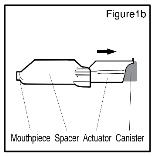
2. To open the inhaler: Pull the purple actuator out from the gray spacer. You will see that there are ribbed finger pads on the sides of the gray spacer.
- Grip the ribbed finger pads on the sides of the gray spacer with the thumb and forefinger of one hand (see Figure 2a).
-
Gently pull on the lip at the top of the purple actuator with the other hand. (See Figure 2b).
- Inspect the spacer and mouthpiece for the presence of foreign objects.
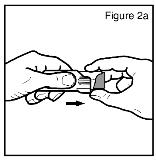
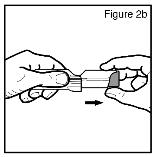
3. To position the inhaler for use: Snap it into an “L” shape (90° angle) as shown in Figure 3. It will only move in one direction.

4. Check that the guide lines on the purple actuator and the gray spacer match up as shown in Figure 4.

- The lines on the ribbed finger pads of the gray spacer should match up with the lines across the back of the purple actuator.
- The lines on the top of the gray spacer and the purple actuator should match up. Make sure there is no opening at the top of the unit where the purple actuator and the gray spacer come together.
- Once the lines are matched up, your AEROSPAN Inhalation Aerosol is ready for use.
5. Place the bottom of the gray spacer on the base of your thumb and your index finger on the top of the metal canister as shown as shown in Figure 5. Your hand will be at the side of the device.
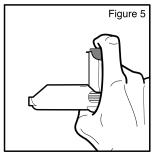
6. Shake the inhaler (see Figure 6).
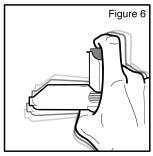
7. If you are using the inhaler for the first time, or if the inhaler has not been used for more than 2 weeks, you will need to prepare (prime) the inhaler. Press down on the metal canister of medicine 2 times for one second each in order to release 2 test sprays into the air away from your face (see Figure 7). Do not spray the medicine in your eyes.
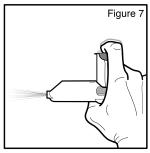
8. Shake the inhaler immediately before each use (see Figure 8).

9. Stand upright with your neck and head straight. Hold the inhaler with the metal canister facing upward and the mouthpiece of the spacer facing toward you. Place your thumb on the bottom of the gray spacer and your index finger on the top of the metal canister (see Figure 9).
![figure 9*[1]](/dailymed/image.cfm?name=aerospan-0e.jpg&archiveid=434838)
10. Breathe in (inhale) and breathe out (exhale) normally through your mouth (see Figure 10).
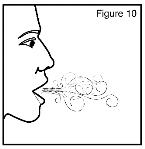
11. After breathing out, bring the inhaler to your mouth and hold the mouthpiece firmly between your lips (see Figure 11).
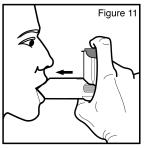
12. Start breathing in slowly. While breathing in, fully depress the metal canister of medicine with your index finger for at least one second (see Figure 12). Continue to breathe in through your mouth for 3 more seconds.
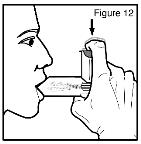
Caution: It is important to begin breathing in through your mouth right before pressing down on the canister. This helps you get the right amount of medicine.
seconds, remove the inhaler from your mouth but do not breathe out yet. Close your lips and hold your breath for at least 10 seconds or as long as comfortable. (see Figure 13).
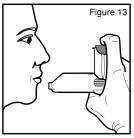
seconds of holding your breath, breathe out and then breathe normally (see Figures 14a and 14b).
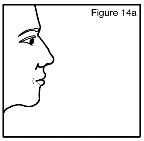
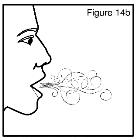
NOTE: If your doctor has prescribed 2 or more sprays (inhalations) at each use, wait 20 seconds, then repeat Steps 8 to 14.
15. To close your inhaler:
- Snap the purple actuator back to the straight position.
- Gently push the purple actuator back into the gray spacer as shown in Figure 15.

16. Rinse your mouth thoroughly with water and spit it out (see Figure 16). This removes any remaining medicine from your mouth. You may also want to brush your teeth.
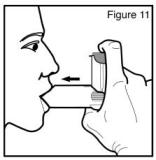
NOTE:
If your mouth becomes sore or you get a rash, tell your doctor — but do not stop using your inhaler unless your doctor tells you to stop.
Remember:
- You will receive a new AEROSPAN Inhalation Aerosol each time you refill your prescription.
- Discard the old inhaler when you get your new one.
How to Check the Contents of Your Canister
Shaking the canister will not tell you how much medicine in the AEROSPAN Inhalation Aerosol is left.
Use one of the check-off charts to keep track of the amount of medicine you have used.
- If your canister has 60 sprays, use the “AEROSPAN Inhalation Aerosol 60 Sprays Check-Off” chart.
- If your canister has 120 sprays, use the “AEROSPAN Inhalation Aerosol 120 Sprays Check-Off” chart.
AEROSPAN Inhalation Aerosol 60 Sprays Check-Off
- Keep this chart with your inhaler or in a handy place.
- If you are using the inhaler for the first time or if you have not used your inhaler for more than 2 weeks, prepare (prime) the inhaler. Follow the instructions provided above in Steps # 5 and #6 then check off the two circled P’s (P = prime) in the chart below.
- Check off a numbered circle each time you use your inhaler. Count each spray. Start with spray # 60.
- Before you reach the final number of sprays, contact your doctor to find out whether you need a refill.
- Keep this chart with your inhaler or in a handy place.
- If you are using the inhaler for the first time or if you have not used your inhaler for more than 2 weeks, prepare (prime) the inhaler. Follow the instructions provided above in Steps # 5 and #6 then check off the two circled P’s (P = prime) in the chart below.
- Check off a numbered circle each time you use your inhaler. Count each spray. Start with spray #120.
- Before you reach the final number of sprays, contact your doctor to find out whether you need a refill.
Discard inhaler after 60 sprays – Discard the inhaler (canister plus actuator) when the labeled number of sprays have been used. The canister is not empty, but you might not get the right amount of medicine in each spray after 60 sprays. Never immerse the canister into water to determine the amount remaining in the canister (“float test”).
P = prime Dosing Sprays

AEROSPAN Inhalation Aerosol 120 Metered Sprays Check-Off
Discard inhaler after 120 sprays – Discard the inhaler (canister plus actuator) when the labeled number of sprays have been used. The canister is not empty, but you might not get the right amount of medicine in each spray after 120 sprays. Never immerse the canister into water to determine the amount remaining in the canister (“float test”).
P = prime Dosing Sprays
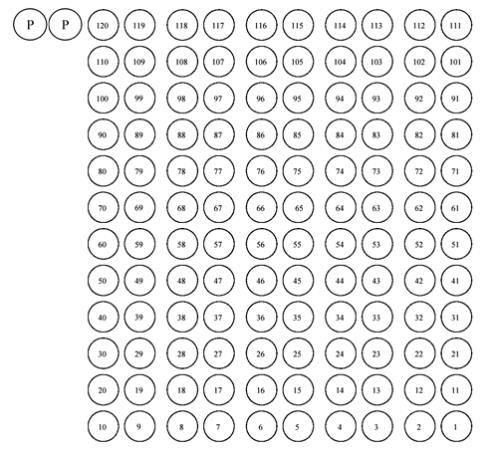
For further information, contact your doctor, or call Forest Laboratories at 1-800-678-1605 extension 66297.
Manufactured By:
3M Pharmaceuticals, Inc.
St. Paul, MN 55133
For:
Forest Pharmaceuticals, Inc.
Subsidiary of Forest Laboratories, Inc.
01/06
PRINCIPAL DISPLAY PANEL
NDC 0456-5550-12
AEROSPAN
(flunisolide HFA, 80 mcg)
Inhalation Aerosol
8.9g 120 metered actuations
Rx Only

| AEROSPAN
flunisolide aerosol, metered |
|||||||||||||||||||||||||
|
|||||||||||||||||||||||||
|
|||||||||||||||||||||||||
|
|||||||||||||||||||||||||
|
|||||||||||||||||||||||||
|
|||||||||||||||||||||||||
| Labeler - Allergan, Inc. (144796497) |
